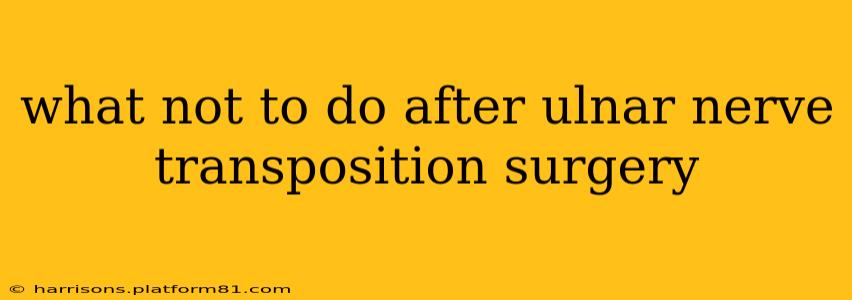Ulnar nerve transposition surgery is a significant procedure aimed at relieving pressure on the ulnar nerve, often causing cubital tunnel syndrome. Recovery requires careful attention to avoid complications and ensure optimal healing. This guide outlines crucial dos and don'ts to facilitate a smooth recovery process. Ignoring these recommendations could hinder healing and potentially lead to setbacks.
Understanding the Procedure:
Before diving into the post-operative guidelines, let's briefly understand what ulnar nerve transposition entails. The surgery involves relocating the ulnar nerve from its vulnerable position behind the elbow to a more protected location in the forearm. This reduces pressure and improves nerve function.
Post-Operative Precautions: What to Absolutely Avoid
Following your ulnar nerve transposition surgery, certain actions must be strictly avoided to prevent complications and promote healing. These precautions are crucial during the initial recovery phase and beyond.
1. Avoid Activities that Stress the Elbow Joint:
This is paramount. Over-stressing the elbow can disrupt the healing process and potentially damage the newly transposed nerve. Activities to avoid include:
- Heavy lifting: Refrain from lifting anything heavy (more than 5-10 pounds) for several weeks, as advised by your surgeon.
- Pushing or pulling: Avoid activities requiring significant pushing or pulling force.
- Repetitive movements: Repeated bending, straightening, or twisting of the elbow should be strictly limited.
- Contact sports: Participating in contact sports or activities with a high risk of elbow injury is strongly discouraged.
2. Protecting the Incision Site:
The incision site needs meticulous care to prevent infection and promote proper healing. Avoid:
- Getting the incision wet: Keep the surgical site dry until your surgeon allows showering.
- Applying direct pressure: Avoid applying excessive pressure or rubbing the incision area.
- Touching or picking at the stitches: Resist the temptation to touch, pick, or scratch the stitches.
3. Ignoring Pain or Swelling:
Pain and swelling are common after surgery, but excessive pain or increasing swelling warrants immediate medical attention. Do not ignore these warning signs. Contact your surgeon immediately if:
- You experience severe pain not controlled by prescribed medication.
- You notice significant increases in swelling or redness around the incision.
- You observe signs of infection, such as pus or fever.
4. Neglecting Physical Therapy:
Physical therapy plays a crucial role in regaining elbow function and range of motion. Do not skip or delay physical therapy sessions. Your therapist will guide you through exercises designed to improve mobility and strength.
5. Overexerting Your Hand and Arm:
While you should gently move your fingers and hand to prevent stiffness, you must avoid overexertion. This could include:
- Aggressive hand exercises: Follow your therapist's instructions carefully and avoid pushing yourself too hard.
- Prolonged hand use: Avoid activities requiring prolonged hand use until your surgeon gives you the all-clear.
Frequently Asked Questions (FAQs)
How long does it take to recover from ulnar nerve transposition surgery?
Recovery time varies significantly depending on individual factors and the extent of the surgery. Full recovery might take several months, with gradual improvements in function over time. Follow your surgeon's instructions closely.
What are the signs of complications after ulnar nerve transposition?
Signs of complications include persistent or worsening numbness, tingling, pain, increased swelling, or infection at the incision site. If you experience any of these, contact your surgeon immediately.
Can I drive after ulnar nerve transposition surgery?
Driving is generally discouraged until you have regained sufficient strength and control in your arm and hand. Follow your surgeon's advice regarding driving.
When can I return to work after ulnar nerve transposition?
Return to work depends on the nature of your job and the degree of recovery. Jobs involving repetitive movements or heavy lifting might require a longer recovery period. Discuss your work situation with your surgeon and physical therapist.
Will I need further surgery after ulnar nerve transposition?
In most cases, ulnar nerve transposition successfully alleviates the nerve compression. However, some patients may require additional procedures depending on their specific circumstances.
Disclaimer: This information is for general educational purposes only and should not be considered medical advice. Always consult with your surgeon and follow their specific post-operative instructions. Your individual recovery will depend on several factors, and this is only a guideline. Proper adherence to post-operative care is essential for a successful outcome.
